Emotional Intelligence and Leadership Development in Nursing Homes
VerifiedAdded on 2023/03/17
|29
|10892
|46
Report
AI Summary
This report evaluates the effectiveness of the Leading Nurses Program, a three-year initiative designed to enhance leadership skills and emotional intelligence among Directors of Nursing (DONs) and other Registered Nurse (RN) leaders in nursing homes. The program aimed to improve resident care by equipping nurse leaders with new skill sets and evidence-based protocols. The study investigates the impact of the program on emotional intelligence and transformational leadership, analyzing data collected to determine whether the educational intervention positively affected these areas. The report highlights the importance of emotional intelligence in nursing, its link to positive outcomes, and the potential of leadership development programs to improve these crucial skills, especially in the context of the growing demands of the healthcare system. The research explores the program's objectives, including assessing differences in emotional intelligence scores, the effectiveness of the educational intervention on leadership skills, and the impact on nurse retention. The findings contribute to the understanding of how emotional intelligence and transformational leadership can be developed in nurses and improve the quality of care provided in nursing homes.
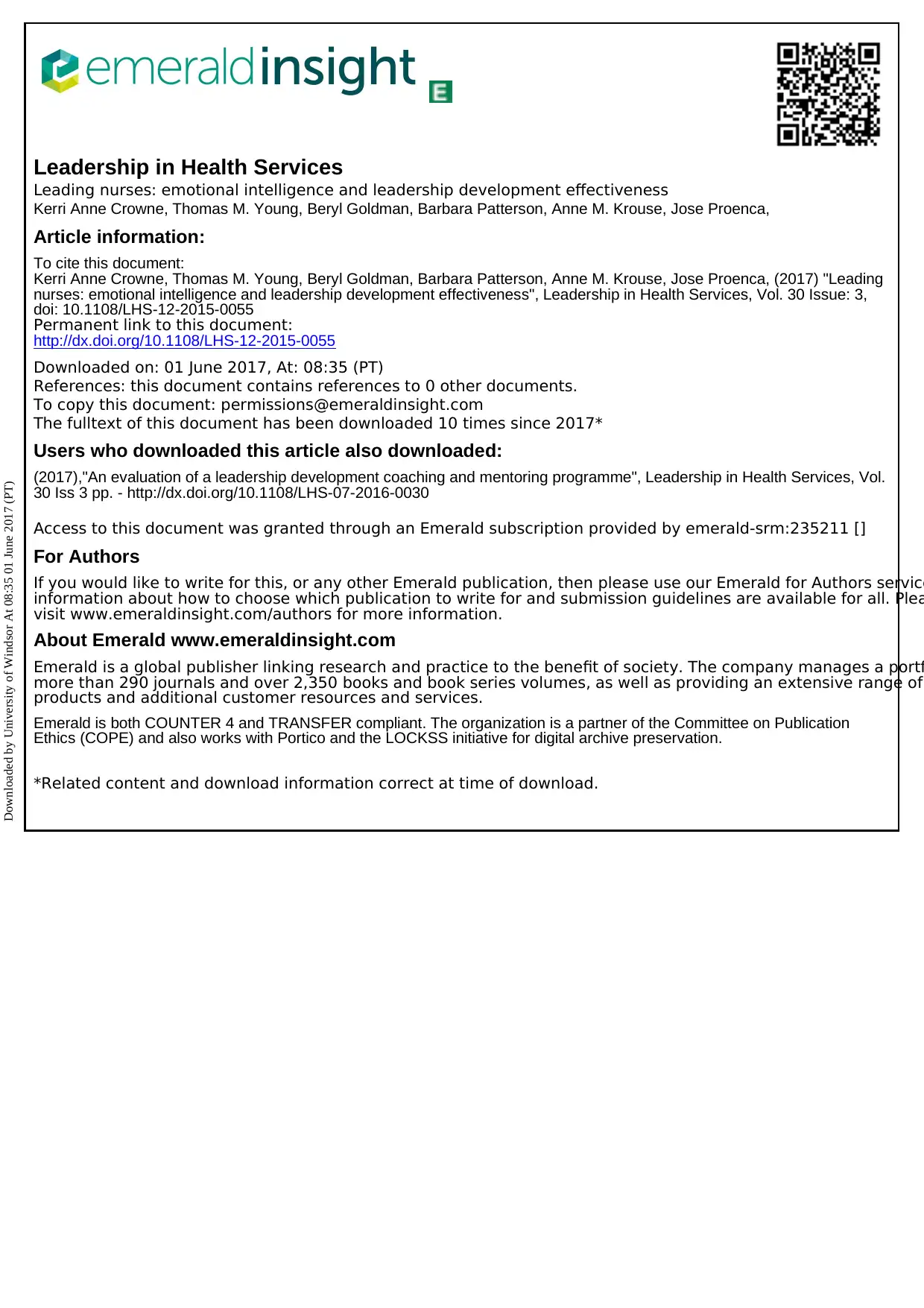
Leadership in Health Services
Leading nurses: emotional intelligence and leadership development effectiveness
Kerri Anne Crowne, Thomas M. Young, Beryl Goldman, Barbara Patterson, Anne M. Krouse, Jose Proenca,
Article information:
To cite this document:
Kerri Anne Crowne, Thomas M. Young, Beryl Goldman, Barbara Patterson, Anne M. Krouse, Jose Proenca, (2017) "Leading
nurses: emotional intelligence and leadership development effectiveness", Leadership in Health Services, Vol. 30 Issue: 3,
doi: 10.1108/LHS-12-2015-0055
Permanent link to this document:
http://dx.doi.org/10.1108/LHS-12-2015-0055
Downloaded on: 01 June 2017, At: 08:35 (PT)
References: this document contains references to 0 other documents.
To copy this document: permissions@emeraldinsight.com
The fulltext of this document has been downloaded 10 times since 2017*
Users who downloaded this article also downloaded:
(2017),"An evaluation of a leadership development coaching and mentoring programme", Leadership in Health Services, Vol.
30 Iss 3 pp. - http://dx.doi.org/10.1108/LHS-07-2016-0030
Access to this document was granted through an Emerald subscription provided by emerald-srm:235211 []
For Authors
If you would like to write for this, or any other Emerald publication, then please use our Emerald for Authors service
information about how to choose which publication to write for and submission guidelines are available for all. Plea
visit www.emeraldinsight.com/authors for more information.
About Emerald www.emeraldinsight.com
Emerald is a global publisher linking research and practice to the benefit of society. The company manages a portf
more than 290 journals and over 2,350 books and book series volumes, as well as providing an extensive range of
products and additional customer resources and services.
Emerald is both COUNTER 4 and TRANSFER compliant. The organization is a partner of the Committee on Publication
Ethics (COPE) and also works with Portico and the LOCKSS initiative for digital archive preservation.
*Related content and download information correct at time of download.
Downloaded by University of Windsor At 08:35 01 June 2017 (PT)
Leading nurses: emotional intelligence and leadership development effectiveness
Kerri Anne Crowne, Thomas M. Young, Beryl Goldman, Barbara Patterson, Anne M. Krouse, Jose Proenca,
Article information:
To cite this document:
Kerri Anne Crowne, Thomas M. Young, Beryl Goldman, Barbara Patterson, Anne M. Krouse, Jose Proenca, (2017) "Leading
nurses: emotional intelligence and leadership development effectiveness", Leadership in Health Services, Vol. 30 Issue: 3,
doi: 10.1108/LHS-12-2015-0055
Permanent link to this document:
http://dx.doi.org/10.1108/LHS-12-2015-0055
Downloaded on: 01 June 2017, At: 08:35 (PT)
References: this document contains references to 0 other documents.
To copy this document: permissions@emeraldinsight.com
The fulltext of this document has been downloaded 10 times since 2017*
Users who downloaded this article also downloaded:
(2017),"An evaluation of a leadership development coaching and mentoring programme", Leadership in Health Services, Vol.
30 Iss 3 pp. - http://dx.doi.org/10.1108/LHS-07-2016-0030
Access to this document was granted through an Emerald subscription provided by emerald-srm:235211 []
For Authors
If you would like to write for this, or any other Emerald publication, then please use our Emerald for Authors service
information about how to choose which publication to write for and submission guidelines are available for all. Plea
visit www.emeraldinsight.com/authors for more information.
About Emerald www.emeraldinsight.com
Emerald is a global publisher linking research and practice to the benefit of society. The company manages a portf
more than 290 journals and over 2,350 books and book series volumes, as well as providing an extensive range of
products and additional customer resources and services.
Emerald is both COUNTER 4 and TRANSFER compliant. The organization is a partner of the Committee on Publication
Ethics (COPE) and also works with Portico and the LOCKSS initiative for digital archive preservation.
*Related content and download information correct at time of download.
Downloaded by University of Windsor At 08:35 01 June 2017 (PT)
Paraphrase This Document
Need a fresh take? Get an instant paraphrase of this document with our AI Paraphraser
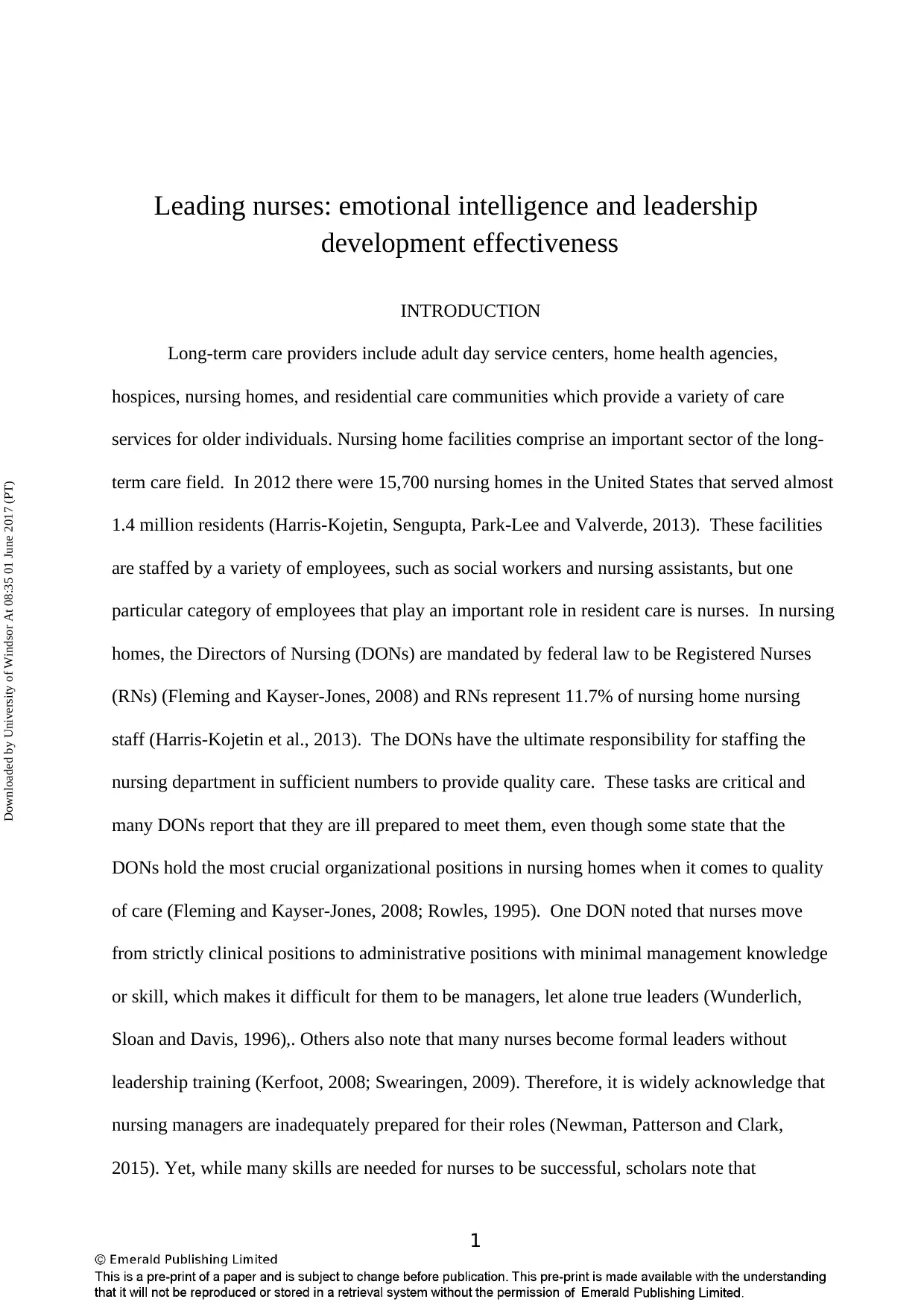
1
Leading nurses: emotional intelligence and leadership
development effectiveness
INTRODUCTION
Long-term care providers include adult day service centers, home health agencies,
hospices, nursing homes, and residential care communities which provide a variety of care
services for older individuals. Nursing home facilities comprise an important sector of the long-
term care field. In 2012 there were 15,700 nursing homes in the United States that served almost
1.4 million residents (Harris-Kojetin, Sengupta, Park-Lee and Valverde, 2013). These facilities
are staffed by a variety of employees, such as social workers and nursing assistants, but one
particular category of employees that play an important role in resident care is nurses. In nursing
homes, the Directors of Nursing (DONs) are mandated by federal law to be Registered Nurses
(RNs) (Fleming and Kayser-Jones, 2008) and RNs represent 11.7% of nursing home nursing
staff (Harris-Kojetin et al., 2013). The DONs have the ultimate responsibility for staffing the
nursing department in sufficient numbers to provide quality care. These tasks are critical and
many DONs report that they are ill prepared to meet them, even though some state that the
DONs hold the most crucial organizational positions in nursing homes when it comes to quality
of care (Fleming and Kayser-Jones, 2008; Rowles, 1995). One DON noted that nurses move
from strictly clinical positions to administrative positions with minimal management knowledge
or skill, which makes it difficult for them to be managers, let alone true leaders (Wunderlich,
Sloan and Davis, 1996),. Others also note that many nurses become formal leaders without
leadership training (Kerfoot, 2008; Swearingen, 2009). Therefore, it is widely acknowledge that
nursing managers are inadequately prepared for their roles (Newman, Patterson and Clark,
2015). Yet, while many skills are needed for nurses to be successful, scholars note that
Downloaded by University of Windsor At 08:35 01 June 2017 (PT)
Leading nurses: emotional intelligence and leadership
development effectiveness
INTRODUCTION
Long-term care providers include adult day service centers, home health agencies,
hospices, nursing homes, and residential care communities which provide a variety of care
services for older individuals. Nursing home facilities comprise an important sector of the long-
term care field. In 2012 there were 15,700 nursing homes in the United States that served almost
1.4 million residents (Harris-Kojetin, Sengupta, Park-Lee and Valverde, 2013). These facilities
are staffed by a variety of employees, such as social workers and nursing assistants, but one
particular category of employees that play an important role in resident care is nurses. In nursing
homes, the Directors of Nursing (DONs) are mandated by federal law to be Registered Nurses
(RNs) (Fleming and Kayser-Jones, 2008) and RNs represent 11.7% of nursing home nursing
staff (Harris-Kojetin et al., 2013). The DONs have the ultimate responsibility for staffing the
nursing department in sufficient numbers to provide quality care. These tasks are critical and
many DONs report that they are ill prepared to meet them, even though some state that the
DONs hold the most crucial organizational positions in nursing homes when it comes to quality
of care (Fleming and Kayser-Jones, 2008; Rowles, 1995). One DON noted that nurses move
from strictly clinical positions to administrative positions with minimal management knowledge
or skill, which makes it difficult for them to be managers, let alone true leaders (Wunderlich,
Sloan and Davis, 1996),. Others also note that many nurses become formal leaders without
leadership training (Kerfoot, 2008; Swearingen, 2009). Therefore, it is widely acknowledge that
nursing managers are inadequately prepared for their roles (Newman, Patterson and Clark,
2015). Yet, while many skills are needed for nurses to be successful, scholars note that
Downloaded by University of Windsor At 08:35 01 June 2017 (PT)
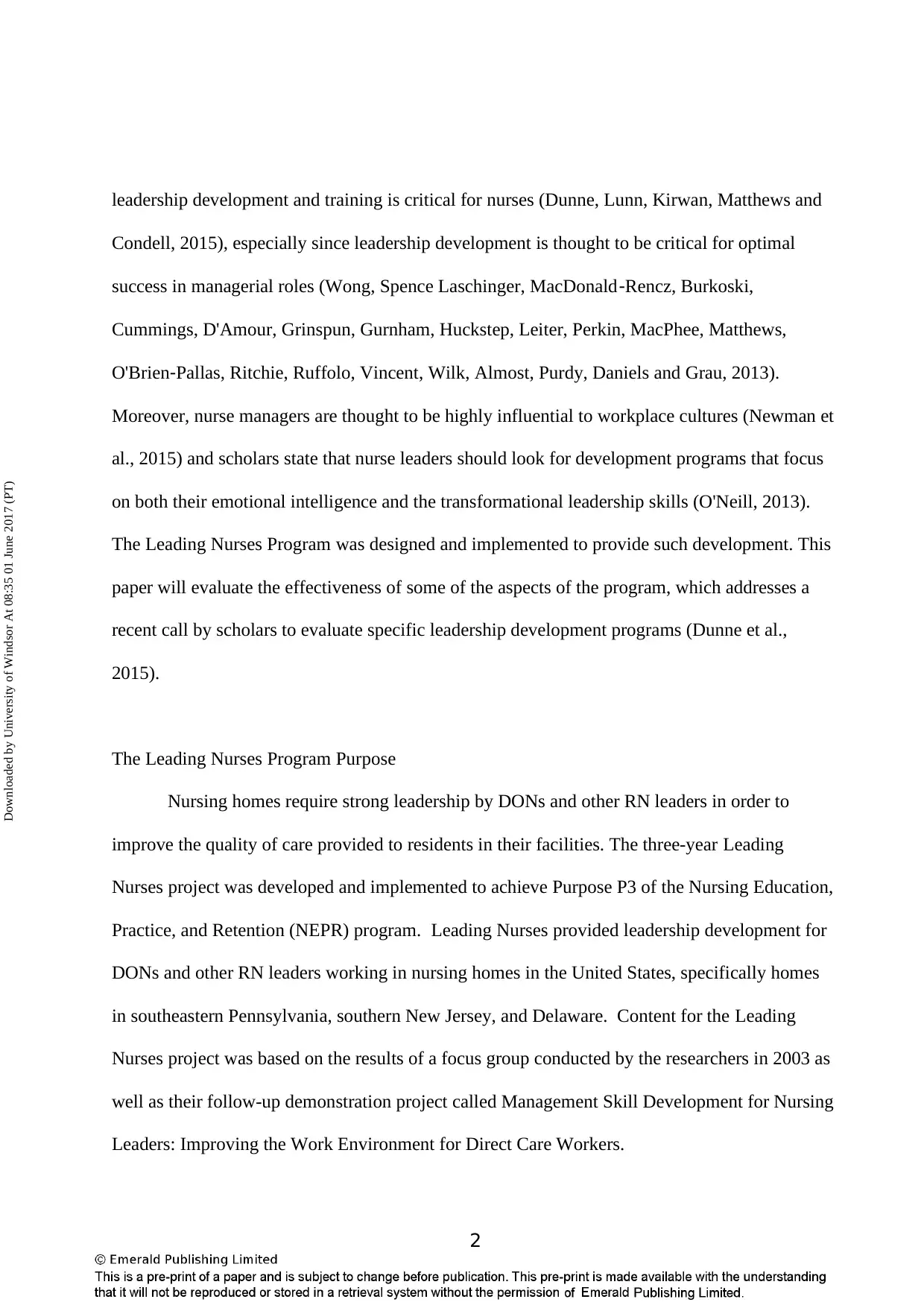
2
leadership development and training is critical for nurses (Dunne, Lunn, Kirwan, Matthews and
Condell, 2015), especially since leadership development is thought to be critical for optimal
success in managerial roles (Wong, Spence Laschinger, MacDonald‐Rencz, Burkoski,
Cummings, D'Amour, Grinspun, Gurnham, Huckstep, Leiter, Perkin, MacPhee, Matthews,
O'Brien‐Pallas, Ritchie, Ruffolo, Vincent, Wilk, Almost, Purdy, Daniels and Grau, 2013).
Moreover, nurse managers are thought to be highly influential to workplace cultures (Newman et
al., 2015) and scholars state that nurse leaders should look for development programs that focus
on both their emotional intelligence and the transformational leadership skills (O'Neill, 2013).
The Leading Nurses Program was designed and implemented to provide such development. This
paper will evaluate the effectiveness of some of the aspects of the program, which addresses a
recent call by scholars to evaluate specific leadership development programs (Dunne et al.,
2015).
The Leading Nurses Program Purpose
Nursing homes require strong leadership by DONs and other RN leaders in order to
improve the quality of care provided to residents in their facilities. The three-year Leading
Nurses project was developed and implemented to achieve Purpose P3 of the Nursing Education,
Practice, and Retention (NEPR) program. Leading Nurses provided leadership development for
DONs and other RN leaders working in nursing homes in the United States, specifically homes
in southeastern Pennsylvania, southern New Jersey, and Delaware. Content for the Leading
Nurses project was based on the results of a focus group conducted by the researchers in 2003 as
well as their follow-up demonstration project called Management Skill Development for Nursing
Leaders: Improving the Work Environment for Direct Care Workers.
Downloaded by University of Windsor At 08:35 01 June 2017 (PT)
leadership development and training is critical for nurses (Dunne, Lunn, Kirwan, Matthews and
Condell, 2015), especially since leadership development is thought to be critical for optimal
success in managerial roles (Wong, Spence Laschinger, MacDonald‐Rencz, Burkoski,
Cummings, D'Amour, Grinspun, Gurnham, Huckstep, Leiter, Perkin, MacPhee, Matthews,
O'Brien‐Pallas, Ritchie, Ruffolo, Vincent, Wilk, Almost, Purdy, Daniels and Grau, 2013).
Moreover, nurse managers are thought to be highly influential to workplace cultures (Newman et
al., 2015) and scholars state that nurse leaders should look for development programs that focus
on both their emotional intelligence and the transformational leadership skills (O'Neill, 2013).
The Leading Nurses Program was designed and implemented to provide such development. This
paper will evaluate the effectiveness of some of the aspects of the program, which addresses a
recent call by scholars to evaluate specific leadership development programs (Dunne et al.,
2015).
The Leading Nurses Program Purpose
Nursing homes require strong leadership by DONs and other RN leaders in order to
improve the quality of care provided to residents in their facilities. The three-year Leading
Nurses project was developed and implemented to achieve Purpose P3 of the Nursing Education,
Practice, and Retention (NEPR) program. Leading Nurses provided leadership development for
DONs and other RN leaders working in nursing homes in the United States, specifically homes
in southeastern Pennsylvania, southern New Jersey, and Delaware. Content for the Leading
Nurses project was based on the results of a focus group conducted by the researchers in 2003 as
well as their follow-up demonstration project called Management Skill Development for Nursing
Leaders: Improving the Work Environment for Direct Care Workers.
Downloaded by University of Windsor At 08:35 01 June 2017 (PT)
⊘ This is a preview!⊘
Do you want full access?
Subscribe today to unlock all pages.

Trusted by 1+ million students worldwide
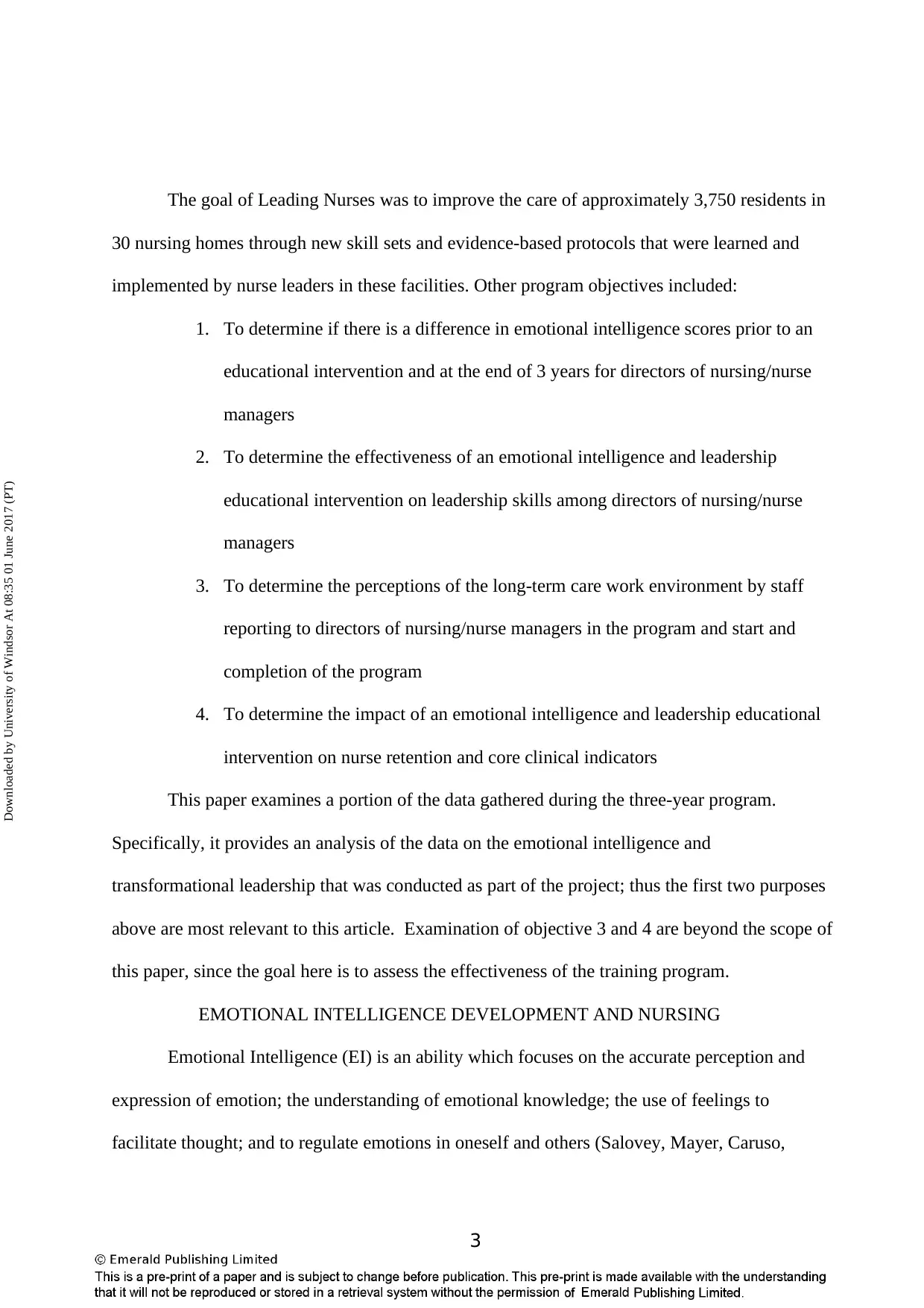
3
The goal of Leading Nurses was to improve the care of approximately 3,750 residents in
30 nursing homes through new skill sets and evidence-based protocols that were learned and
implemented by nurse leaders in these facilities. Other program objectives included:
1. To determine if there is a difference in emotional intelligence scores prior to an
educational intervention and at the end of 3 years for directors of nursing/nurse
managers
2. To determine the effectiveness of an emotional intelligence and leadership
educational intervention on leadership skills among directors of nursing/nurse
managers
3. To determine the perceptions of the long-term care work environment by staff
reporting to directors of nursing/nurse managers in the program and start and
completion of the program
4. To determine the impact of an emotional intelligence and leadership educational
intervention on nurse retention and core clinical indicators
This paper examines a portion of the data gathered during the three-year program.
Specifically, it provides an analysis of the data on the emotional intelligence and
transformational leadership that was conducted as part of the project; thus the first two purposes
above are most relevant to this article. Examination of objective 3 and 4 are beyond the scope of
this paper, since the goal here is to assess the effectiveness of the training program.
EMOTIONAL INTELLIGENCE DEVELOPMENT AND NURSING
Emotional Intelligence (EI) is an ability which focuses on the accurate perception and
expression of emotion; the understanding of emotional knowledge; the use of feelings to
facilitate thought; and to regulate emotions in oneself and others (Salovey, Mayer, Caruso,
Downloaded by University of Windsor At 08:35 01 June 2017 (PT)
The goal of Leading Nurses was to improve the care of approximately 3,750 residents in
30 nursing homes through new skill sets and evidence-based protocols that were learned and
implemented by nurse leaders in these facilities. Other program objectives included:
1. To determine if there is a difference in emotional intelligence scores prior to an
educational intervention and at the end of 3 years for directors of nursing/nurse
managers
2. To determine the effectiveness of an emotional intelligence and leadership
educational intervention on leadership skills among directors of nursing/nurse
managers
3. To determine the perceptions of the long-term care work environment by staff
reporting to directors of nursing/nurse managers in the program and start and
completion of the program
4. To determine the impact of an emotional intelligence and leadership educational
intervention on nurse retention and core clinical indicators
This paper examines a portion of the data gathered during the three-year program.
Specifically, it provides an analysis of the data on the emotional intelligence and
transformational leadership that was conducted as part of the project; thus the first two purposes
above are most relevant to this article. Examination of objective 3 and 4 are beyond the scope of
this paper, since the goal here is to assess the effectiveness of the training program.
EMOTIONAL INTELLIGENCE DEVELOPMENT AND NURSING
Emotional Intelligence (EI) is an ability which focuses on the accurate perception and
expression of emotion; the understanding of emotional knowledge; the use of feelings to
facilitate thought; and to regulate emotions in oneself and others (Salovey, Mayer, Caruso,
Downloaded by University of Windsor At 08:35 01 June 2017 (PT)
Paraphrase This Document
Need a fresh take? Get an instant paraphrase of this document with our AI Paraphraser
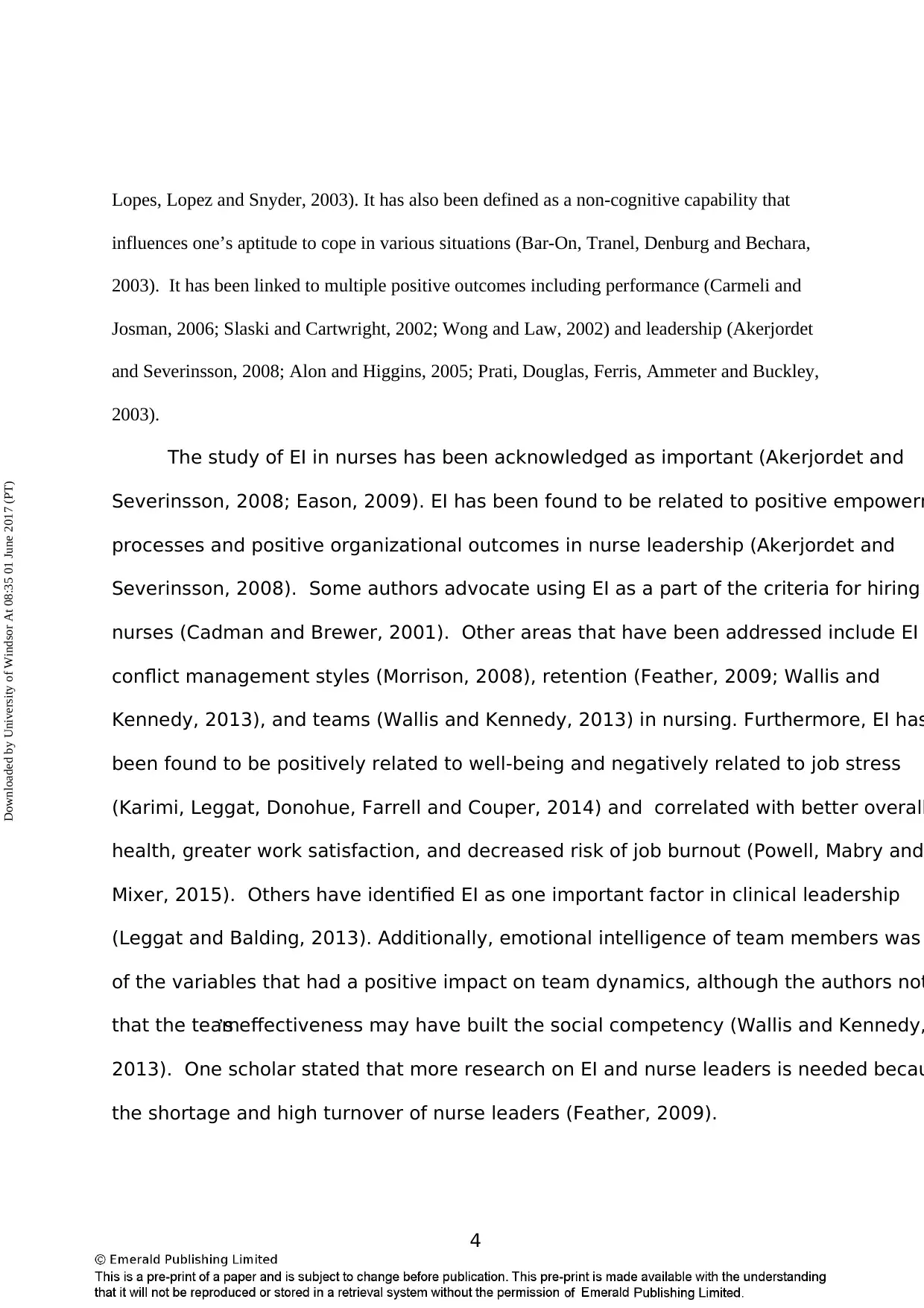
4
Lopes, Lopez and Snyder, 2003). It has also been defined as a non-cognitive capability that
influences one’s aptitude to cope in various situations (Bar-On, Tranel, Denburg and Bechara,
2003). It has been linked to multiple positive outcomes including performance (Carmeli and
Josman, 2006; Slaski and Cartwright, 2002; Wong and Law, 2002) and leadership (Akerjordet
and Severinsson, 2008; Alon and Higgins, 2005; Prati, Douglas, Ferris, Ammeter and Buckley,
2003).
The study of EI in nurses has been acknowledged as important (Akerjordet and
Severinsson, 2008; Eason, 2009). EI has been found to be related to positive empowerm
processes and positive organizational outcomes in nurse leadership (Akerjordet and
Severinsson, 2008). Some authors advocate using EI as a part of the criteria for hiring
nurses (Cadman and Brewer, 2001). Other areas that have been addressed include EI
conflict management styles (Morrison, 2008), retention (Feather, 2009; Wallis and
Kennedy, 2013), and teams (Wallis and Kennedy, 2013) in nursing. Furthermore, EI has
been found to be positively related to well-being and negatively related to job stress
(Karimi, Leggat, Donohue, Farrell and Couper, 2014) and correlated with better overall
health, greater work satisfaction, and decreased risk of job burnout (Powell, Mabry and
Mixer, 2015). Others have identified EI as one important factor in clinical leadership
(Leggat and Balding, 2013). Additionally, emotional intelligence of team members was
of the variables that had a positive impact on team dynamics, although the authors not
that the team’s effectiveness may have built the social competency (Wallis and Kennedy,
2013). One scholar stated that more research on EI and nurse leaders is needed becau
the shortage and high turnover of nurse leaders (Feather, 2009).
Downloaded by University of Windsor At 08:35 01 June 2017 (PT)
Lopes, Lopez and Snyder, 2003). It has also been defined as a non-cognitive capability that
influences one’s aptitude to cope in various situations (Bar-On, Tranel, Denburg and Bechara,
2003). It has been linked to multiple positive outcomes including performance (Carmeli and
Josman, 2006; Slaski and Cartwright, 2002; Wong and Law, 2002) and leadership (Akerjordet
and Severinsson, 2008; Alon and Higgins, 2005; Prati, Douglas, Ferris, Ammeter and Buckley,
2003).
The study of EI in nurses has been acknowledged as important (Akerjordet and
Severinsson, 2008; Eason, 2009). EI has been found to be related to positive empowerm
processes and positive organizational outcomes in nurse leadership (Akerjordet and
Severinsson, 2008). Some authors advocate using EI as a part of the criteria for hiring
nurses (Cadman and Brewer, 2001). Other areas that have been addressed include EI
conflict management styles (Morrison, 2008), retention (Feather, 2009; Wallis and
Kennedy, 2013), and teams (Wallis and Kennedy, 2013) in nursing. Furthermore, EI has
been found to be positively related to well-being and negatively related to job stress
(Karimi, Leggat, Donohue, Farrell and Couper, 2014) and correlated with better overall
health, greater work satisfaction, and decreased risk of job burnout (Powell, Mabry and
Mixer, 2015). Others have identified EI as one important factor in clinical leadership
(Leggat and Balding, 2013). Additionally, emotional intelligence of team members was
of the variables that had a positive impact on team dynamics, although the authors not
that the team’s effectiveness may have built the social competency (Wallis and Kennedy,
2013). One scholar stated that more research on EI and nurse leaders is needed becau
the shortage and high turnover of nurse leaders (Feather, 2009).
Downloaded by University of Windsor At 08:35 01 June 2017 (PT)
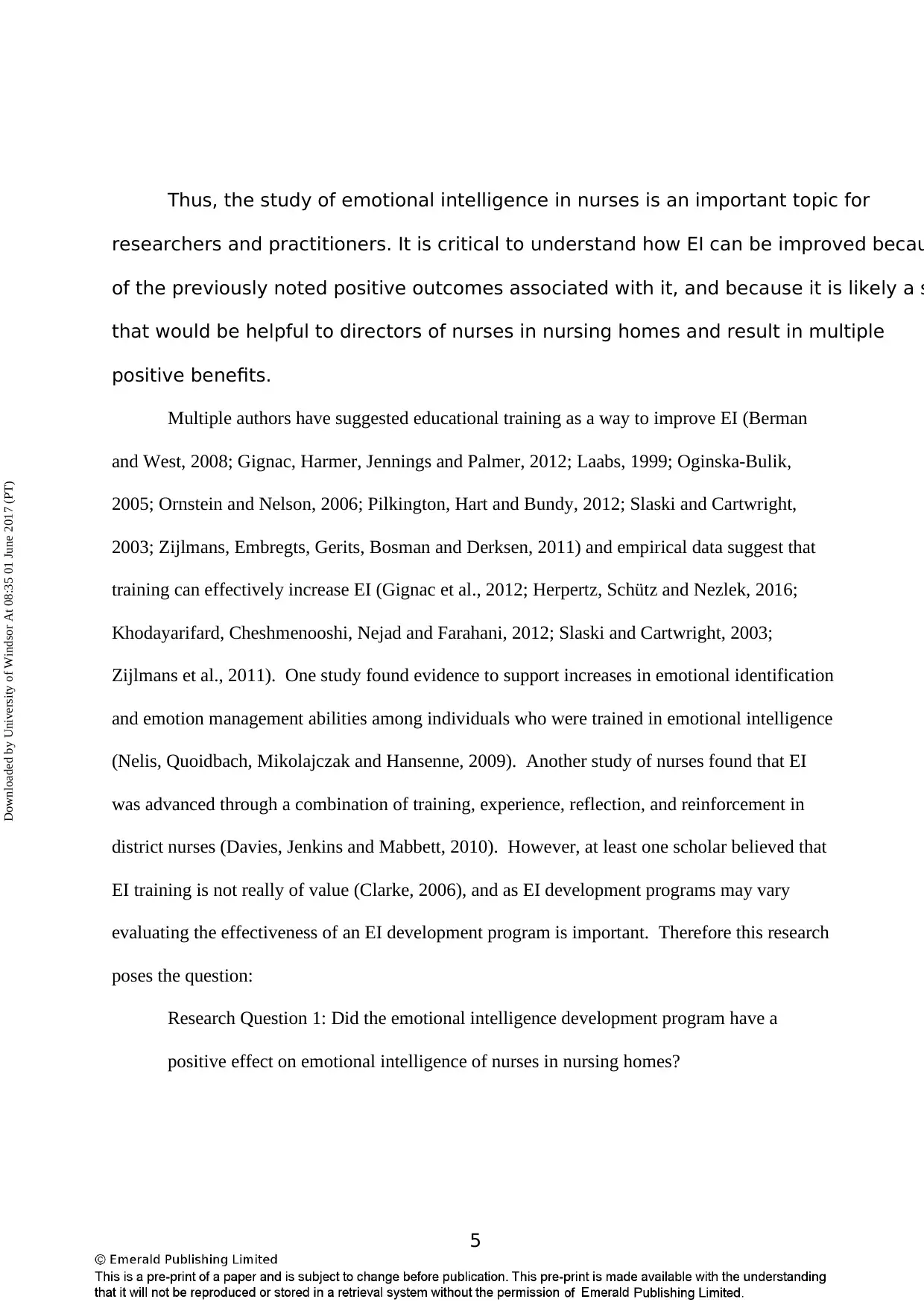
5
Thus, the study of emotional intelligence in nurses is an important topic for
researchers and practitioners. It is critical to understand how EI can be improved becau
of the previously noted positive outcomes associated with it, and because it is likely a s
that would be helpful to directors of nurses in nursing homes and result in multiple
positive benefits.
Multiple authors have suggested educational training as a way to improve EI (Berman
and West, 2008; Gignac, Harmer, Jennings and Palmer, 2012; Laabs, 1999; Oginska-Bulik,
2005; Ornstein and Nelson, 2006; Pilkington, Hart and Bundy, 2012; Slaski and Cartwright,
2003; Zijlmans, Embregts, Gerits, Bosman and Derksen, 2011) and empirical data suggest that
training can effectively increase EI (Gignac et al., 2012; Herpertz, Schütz and Nezlek, 2016;
Khodayarifard, Cheshmenooshi, Nejad and Farahani, 2012; Slaski and Cartwright, 2003;
Zijlmans et al., 2011). One study found evidence to support increases in emotional identification
and emotion management abilities among individuals who were trained in emotional intelligence
(Nelis, Quoidbach, Mikolajczak and Hansenne, 2009). Another study of nurses found that EI
was advanced through a combination of training, experience, reflection, and reinforcement in
district nurses (Davies, Jenkins and Mabbett, 2010). However, at least one scholar believed that
EI training is not really of value (Clarke, 2006), and as EI development programs may vary
evaluating the effectiveness of an EI development program is important. Therefore this research
poses the question:
Research Question 1: Did the emotional intelligence development program have a
positive effect on emotional intelligence of nurses in nursing homes?
Downloaded by University of Windsor At 08:35 01 June 2017 (PT)
Thus, the study of emotional intelligence in nurses is an important topic for
researchers and practitioners. It is critical to understand how EI can be improved becau
of the previously noted positive outcomes associated with it, and because it is likely a s
that would be helpful to directors of nurses in nursing homes and result in multiple
positive benefits.
Multiple authors have suggested educational training as a way to improve EI (Berman
and West, 2008; Gignac, Harmer, Jennings and Palmer, 2012; Laabs, 1999; Oginska-Bulik,
2005; Ornstein and Nelson, 2006; Pilkington, Hart and Bundy, 2012; Slaski and Cartwright,
2003; Zijlmans, Embregts, Gerits, Bosman and Derksen, 2011) and empirical data suggest that
training can effectively increase EI (Gignac et al., 2012; Herpertz, Schütz and Nezlek, 2016;
Khodayarifard, Cheshmenooshi, Nejad and Farahani, 2012; Slaski and Cartwright, 2003;
Zijlmans et al., 2011). One study found evidence to support increases in emotional identification
and emotion management abilities among individuals who were trained in emotional intelligence
(Nelis, Quoidbach, Mikolajczak and Hansenne, 2009). Another study of nurses found that EI
was advanced through a combination of training, experience, reflection, and reinforcement in
district nurses (Davies, Jenkins and Mabbett, 2010). However, at least one scholar believed that
EI training is not really of value (Clarke, 2006), and as EI development programs may vary
evaluating the effectiveness of an EI development program is important. Therefore this research
poses the question:
Research Question 1: Did the emotional intelligence development program have a
positive effect on emotional intelligence of nurses in nursing homes?
Downloaded by University of Windsor At 08:35 01 June 2017 (PT)
⊘ This is a preview!⊘
Do you want full access?
Subscribe today to unlock all pages.

Trusted by 1+ million students worldwide
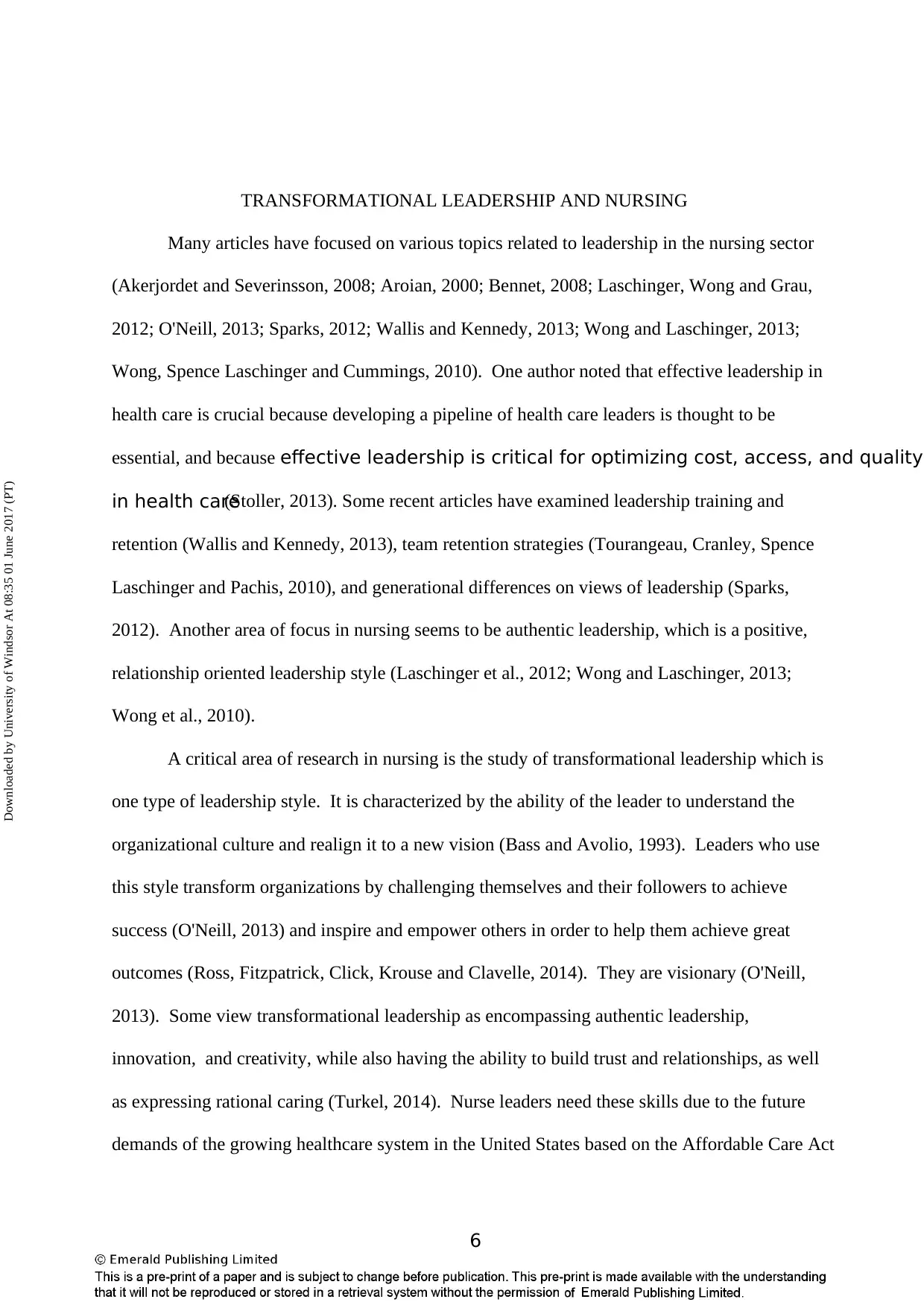
6
TRANSFORMATIONAL LEADERSHIP AND NURSING
Many articles have focused on various topics related to leadership in the nursing sector
(Akerjordet and Severinsson, 2008; Aroian, 2000; Bennet, 2008; Laschinger, Wong and Grau,
2012; O'Neill, 2013; Sparks, 2012; Wallis and Kennedy, 2013; Wong and Laschinger, 2013;
Wong, Spence Laschinger and Cummings, 2010). One author noted that effective leadership in
health care is crucial because developing a pipeline of health care leaders is thought to be
essential, and because effective leadership is critical for optimizing cost, access, and quality
in health care(Stoller, 2013). Some recent articles have examined leadership training and
retention (Wallis and Kennedy, 2013), team retention strategies (Tourangeau, Cranley, Spence
Laschinger and Pachis, 2010), and generational differences on views of leadership (Sparks,
2012). Another area of focus in nursing seems to be authentic leadership, which is a positive,
relationship oriented leadership style (Laschinger et al., 2012; Wong and Laschinger, 2013;
Wong et al., 2010).
A critical area of research in nursing is the study of transformational leadership which is
one type of leadership style. It is characterized by the ability of the leader to understand the
organizational culture and realign it to a new vision (Bass and Avolio, 1993). Leaders who use
this style transform organizations by challenging themselves and their followers to achieve
success (O'Neill, 2013) and inspire and empower others in order to help them achieve great
outcomes (Ross, Fitzpatrick, Click, Krouse and Clavelle, 2014). They are visionary (O'Neill,
2013). Some view transformational leadership as encompassing authentic leadership,
innovation, and creativity, while also having the ability to build trust and relationships, as well
as expressing rational caring (Turkel, 2014). Nurse leaders need these skills due to the future
demands of the growing healthcare system in the United States based on the Affordable Care Act
Downloaded by University of Windsor At 08:35 01 June 2017 (PT)
TRANSFORMATIONAL LEADERSHIP AND NURSING
Many articles have focused on various topics related to leadership in the nursing sector
(Akerjordet and Severinsson, 2008; Aroian, 2000; Bennet, 2008; Laschinger, Wong and Grau,
2012; O'Neill, 2013; Sparks, 2012; Wallis and Kennedy, 2013; Wong and Laschinger, 2013;
Wong, Spence Laschinger and Cummings, 2010). One author noted that effective leadership in
health care is crucial because developing a pipeline of health care leaders is thought to be
essential, and because effective leadership is critical for optimizing cost, access, and quality
in health care(Stoller, 2013). Some recent articles have examined leadership training and
retention (Wallis and Kennedy, 2013), team retention strategies (Tourangeau, Cranley, Spence
Laschinger and Pachis, 2010), and generational differences on views of leadership (Sparks,
2012). Another area of focus in nursing seems to be authentic leadership, which is a positive,
relationship oriented leadership style (Laschinger et al., 2012; Wong and Laschinger, 2013;
Wong et al., 2010).
A critical area of research in nursing is the study of transformational leadership which is
one type of leadership style. It is characterized by the ability of the leader to understand the
organizational culture and realign it to a new vision (Bass and Avolio, 1993). Leaders who use
this style transform organizations by challenging themselves and their followers to achieve
success (O'Neill, 2013) and inspire and empower others in order to help them achieve great
outcomes (Ross, Fitzpatrick, Click, Krouse and Clavelle, 2014). They are visionary (O'Neill,
2013). Some view transformational leadership as encompassing authentic leadership,
innovation, and creativity, while also having the ability to build trust and relationships, as well
as expressing rational caring (Turkel, 2014). Nurse leaders need these skills due to the future
demands of the growing healthcare system in the United States based on the Affordable Care Act
Downloaded by University of Windsor At 08:35 01 June 2017 (PT)
Paraphrase This Document
Need a fresh take? Get an instant paraphrase of this document with our AI Paraphraser
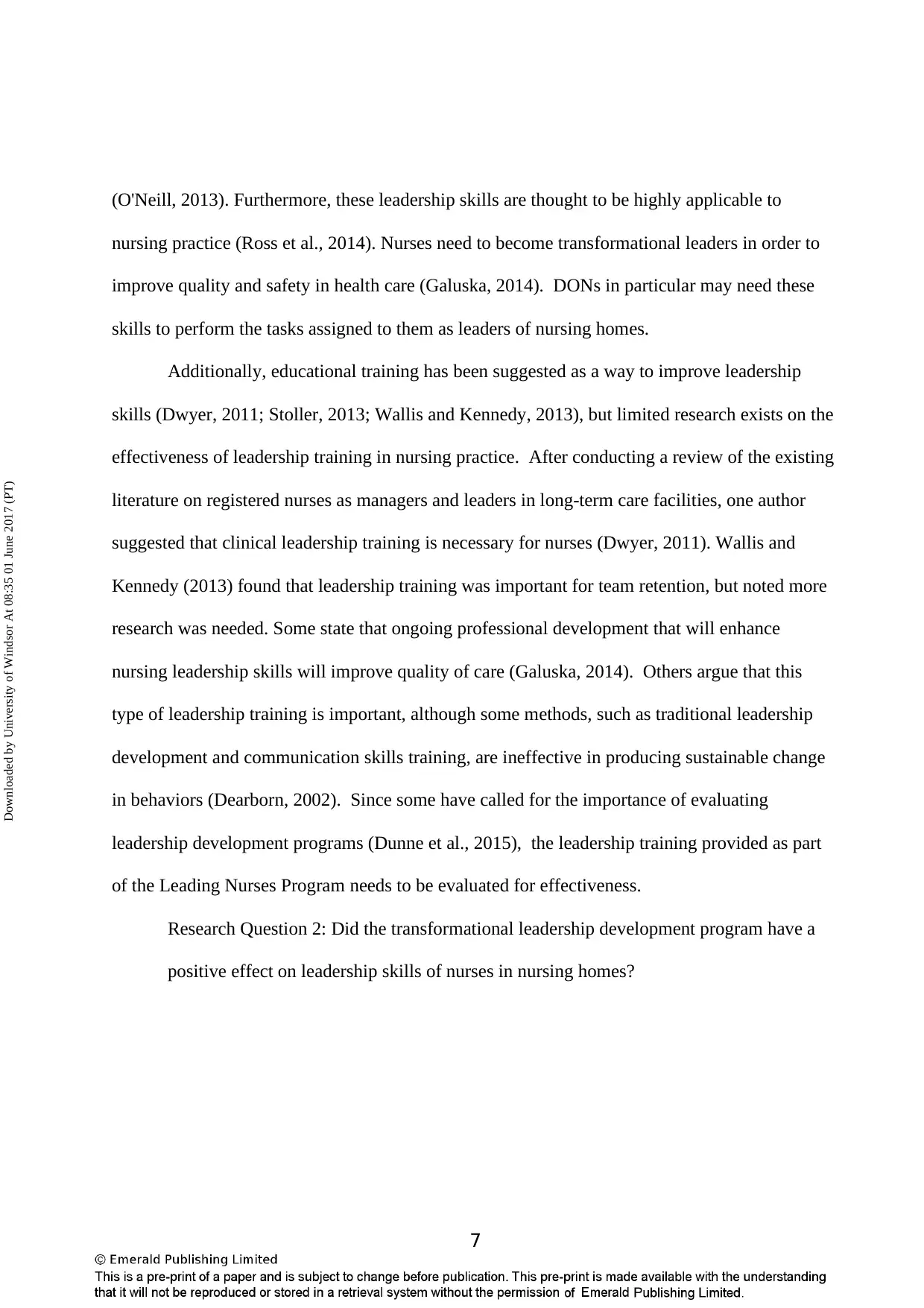
7
(O'Neill, 2013). Furthermore, these leadership skills are thought to be highly applicable to
nursing practice (Ross et al., 2014). Nurses need to become transformational leaders in order to
improve quality and safety in health care (Galuska, 2014). DONs in particular may need these
skills to perform the tasks assigned to them as leaders of nursing homes.
Additionally, educational training has been suggested as a way to improve leadership
skills (Dwyer, 2011; Stoller, 2013; Wallis and Kennedy, 2013), but limited research exists on the
effectiveness of leadership training in nursing practice. After conducting a review of the existing
literature on registered nurses as managers and leaders in long-term care facilities, one author
suggested that clinical leadership training is necessary for nurses (Dwyer, 2011). Wallis and
Kennedy (2013) found that leadership training was important for team retention, but noted more
research was needed. Some state that ongoing professional development that will enhance
nursing leadership skills will improve quality of care (Galuska, 2014). Others argue that this
type of leadership training is important, although some methods, such as traditional leadership
development and communication skills training, are ineffective in producing sustainable change
in behaviors (Dearborn, 2002). Since some have called for the importance of evaluating
leadership development programs (Dunne et al., 2015), the leadership training provided as part
of the Leading Nurses Program needs to be evaluated for effectiveness.
Research Question 2: Did the transformational leadership development program have a
positive effect on leadership skills of nurses in nursing homes?
Downloaded by University of Windsor At 08:35 01 June 2017 (PT)
(O'Neill, 2013). Furthermore, these leadership skills are thought to be highly applicable to
nursing practice (Ross et al., 2014). Nurses need to become transformational leaders in order to
improve quality and safety in health care (Galuska, 2014). DONs in particular may need these
skills to perform the tasks assigned to them as leaders of nursing homes.
Additionally, educational training has been suggested as a way to improve leadership
skills (Dwyer, 2011; Stoller, 2013; Wallis and Kennedy, 2013), but limited research exists on the
effectiveness of leadership training in nursing practice. After conducting a review of the existing
literature on registered nurses as managers and leaders in long-term care facilities, one author
suggested that clinical leadership training is necessary for nurses (Dwyer, 2011). Wallis and
Kennedy (2013) found that leadership training was important for team retention, but noted more
research was needed. Some state that ongoing professional development that will enhance
nursing leadership skills will improve quality of care (Galuska, 2014). Others argue that this
type of leadership training is important, although some methods, such as traditional leadership
development and communication skills training, are ineffective in producing sustainable change
in behaviors (Dearborn, 2002). Since some have called for the importance of evaluating
leadership development programs (Dunne et al., 2015), the leadership training provided as part
of the Leading Nurses Program needs to be evaluated for effectiveness.
Research Question 2: Did the transformational leadership development program have a
positive effect on leadership skills of nurses in nursing homes?
Downloaded by University of Windsor At 08:35 01 June 2017 (PT)
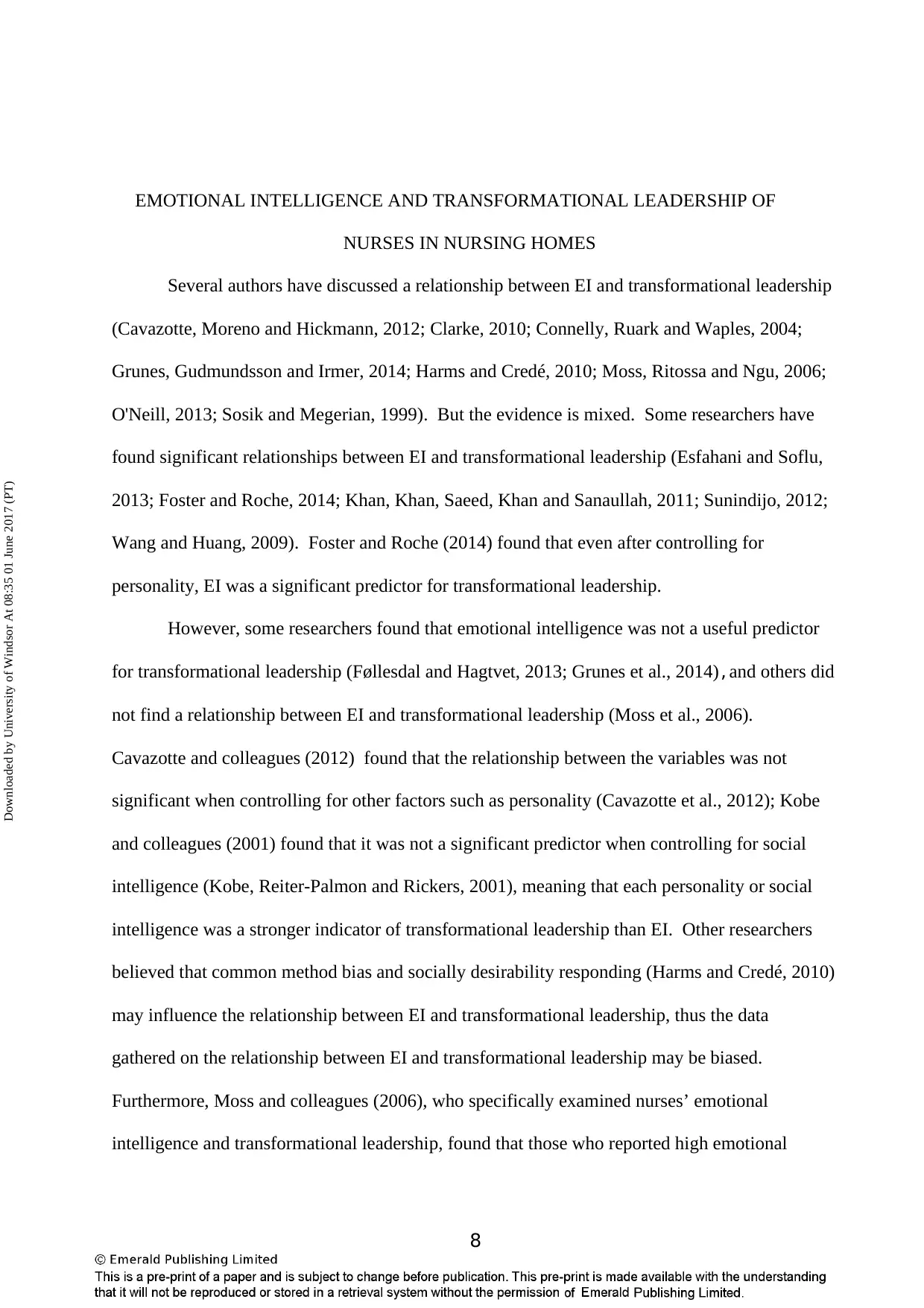
8
EMOTIONAL INTELLIGENCE AND TRANSFORMATIONAL LEADERSHIP OF
NURSES IN NURSING HOMES
Several authors have discussed a relationship between EI and transformational leadership
(Cavazotte, Moreno and Hickmann, 2012; Clarke, 2010; Connelly, Ruark and Waples, 2004;
Grunes, Gudmundsson and Irmer, 2014; Harms and Credé, 2010; Moss, Ritossa and Ngu, 2006;
O'Neill, 2013; Sosik and Megerian, 1999). But the evidence is mixed. Some researchers have
found significant relationships between EI and transformational leadership (Esfahani and Soflu,
2013; Foster and Roche, 2014; Khan, Khan, Saeed, Khan and Sanaullah, 2011; Sunindijo, 2012;
Wang and Huang, 2009). Foster and Roche (2014) found that even after controlling for
personality, EI was a significant predictor for transformational leadership.
However, some researchers found that emotional intelligence was not a useful predictor
for transformational leadership (Føllesdal and Hagtvet, 2013; Grunes et al., 2014), and others did
not find a relationship between EI and transformational leadership (Moss et al., 2006).
Cavazotte and colleagues (2012) found that the relationship between the variables was not
significant when controlling for other factors such as personality (Cavazotte et al., 2012); Kobe
and colleagues (2001) found that it was not a significant predictor when controlling for social
intelligence (Kobe, Reiter-Palmon and Rickers, 2001), meaning that each personality or social
intelligence was a stronger indicator of transformational leadership than EI. Other researchers
believed that common method bias and socially desirability responding (Harms and Credé, 2010)
may influence the relationship between EI and transformational leadership, thus the data
gathered on the relationship between EI and transformational leadership may be biased.
Furthermore, Moss and colleagues (2006), who specifically examined nurses’ emotional
intelligence and transformational leadership, found that those who reported high emotional
Downloaded by University of Windsor At 08:35 01 June 2017 (PT)
EMOTIONAL INTELLIGENCE AND TRANSFORMATIONAL LEADERSHIP OF
NURSES IN NURSING HOMES
Several authors have discussed a relationship between EI and transformational leadership
(Cavazotte, Moreno and Hickmann, 2012; Clarke, 2010; Connelly, Ruark and Waples, 2004;
Grunes, Gudmundsson and Irmer, 2014; Harms and Credé, 2010; Moss, Ritossa and Ngu, 2006;
O'Neill, 2013; Sosik and Megerian, 1999). But the evidence is mixed. Some researchers have
found significant relationships between EI and transformational leadership (Esfahani and Soflu,
2013; Foster and Roche, 2014; Khan, Khan, Saeed, Khan and Sanaullah, 2011; Sunindijo, 2012;
Wang and Huang, 2009). Foster and Roche (2014) found that even after controlling for
personality, EI was a significant predictor for transformational leadership.
However, some researchers found that emotional intelligence was not a useful predictor
for transformational leadership (Føllesdal and Hagtvet, 2013; Grunes et al., 2014), and others did
not find a relationship between EI and transformational leadership (Moss et al., 2006).
Cavazotte and colleagues (2012) found that the relationship between the variables was not
significant when controlling for other factors such as personality (Cavazotte et al., 2012); Kobe
and colleagues (2001) found that it was not a significant predictor when controlling for social
intelligence (Kobe, Reiter-Palmon and Rickers, 2001), meaning that each personality or social
intelligence was a stronger indicator of transformational leadership than EI. Other researchers
believed that common method bias and socially desirability responding (Harms and Credé, 2010)
may influence the relationship between EI and transformational leadership, thus the data
gathered on the relationship between EI and transformational leadership may be biased.
Furthermore, Moss and colleagues (2006), who specifically examined nurses’ emotional
intelligence and transformational leadership, found that those who reported high emotional
Downloaded by University of Windsor At 08:35 01 June 2017 (PT)
⊘ This is a preview!⊘
Do you want full access?
Subscribe today to unlock all pages.

Trusted by 1+ million students worldwide
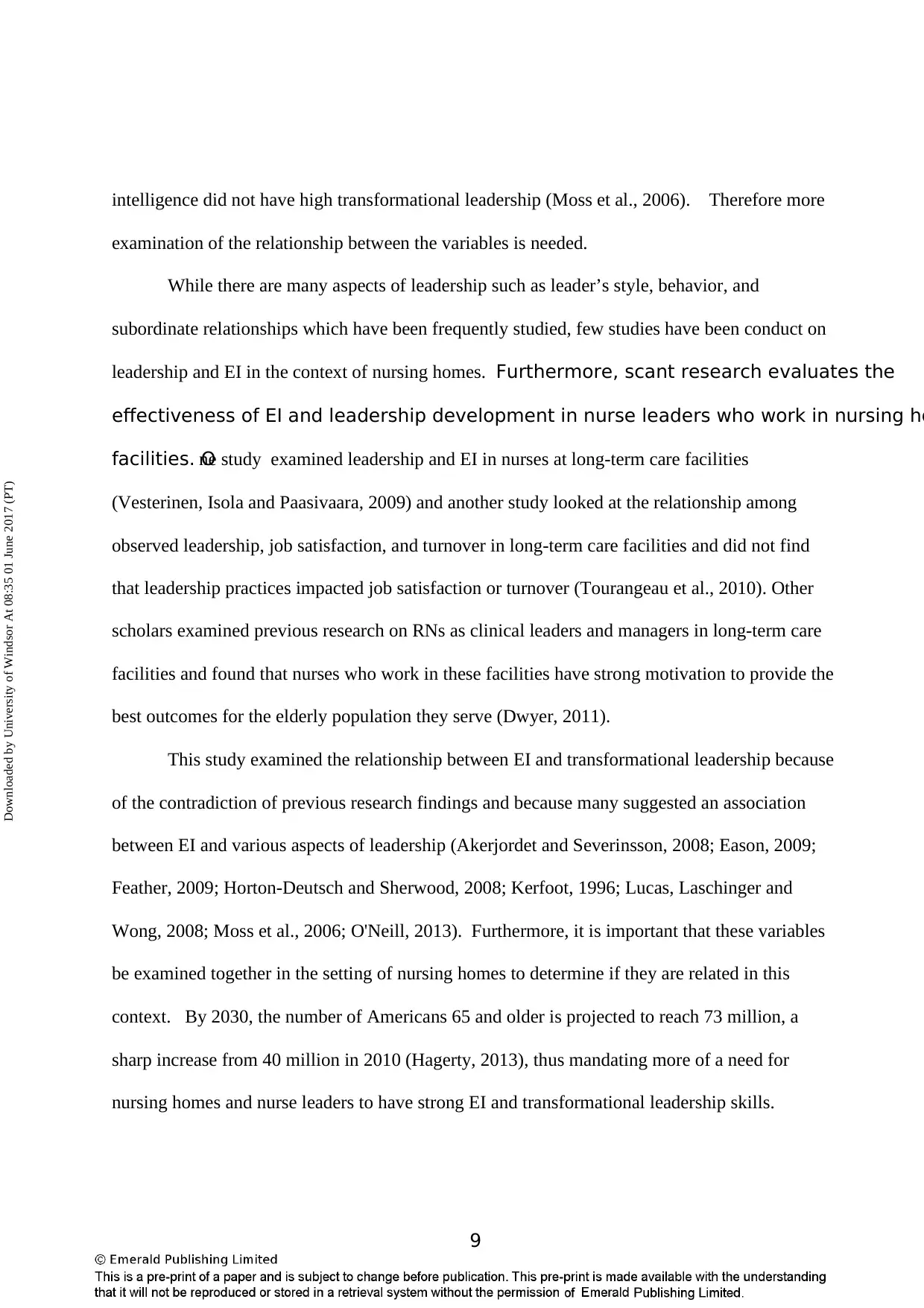
9
intelligence did not have high transformational leadership (Moss et al., 2006). Therefore more
examination of the relationship between the variables is needed.
While there are many aspects of leadership such as leader’s style, behavior, and
subordinate relationships which have been frequently studied, few studies have been conduct on
leadership and EI in the context of nursing homes. Furthermore, scant research evaluates the
effectiveness of EI and leadership development in nurse leaders who work in nursing ho
facilities. One study examined leadership and EI in nurses at long-term care facilities
(Vesterinen, Isola and Paasivaara, 2009) and another study looked at the relationship among
observed leadership, job satisfaction, and turnover in long-term care facilities and did not find
that leadership practices impacted job satisfaction or turnover (Tourangeau et al., 2010). Other
scholars examined previous research on RNs as clinical leaders and managers in long-term care
facilities and found that nurses who work in these facilities have strong motivation to provide the
best outcomes for the elderly population they serve (Dwyer, 2011).
This study examined the relationship between EI and transformational leadership because
of the contradiction of previous research findings and because many suggested an association
between EI and various aspects of leadership (Akerjordet and Severinsson, 2008; Eason, 2009;
Feather, 2009; Horton-Deutsch and Sherwood, 2008; Kerfoot, 1996; Lucas, Laschinger and
Wong, 2008; Moss et al., 2006; O'Neill, 2013). Furthermore, it is important that these variables
be examined together in the setting of nursing homes to determine if they are related in this
context. By 2030, the number of Americans 65 and older is projected to reach 73 million, a
sharp increase from 40 million in 2010 (Hagerty, 2013), thus mandating more of a need for
nursing homes and nurse leaders to have strong EI and transformational leadership skills.
Downloaded by University of Windsor At 08:35 01 June 2017 (PT)
intelligence did not have high transformational leadership (Moss et al., 2006). Therefore more
examination of the relationship between the variables is needed.
While there are many aspects of leadership such as leader’s style, behavior, and
subordinate relationships which have been frequently studied, few studies have been conduct on
leadership and EI in the context of nursing homes. Furthermore, scant research evaluates the
effectiveness of EI and leadership development in nurse leaders who work in nursing ho
facilities. One study examined leadership and EI in nurses at long-term care facilities
(Vesterinen, Isola and Paasivaara, 2009) and another study looked at the relationship among
observed leadership, job satisfaction, and turnover in long-term care facilities and did not find
that leadership practices impacted job satisfaction or turnover (Tourangeau et al., 2010). Other
scholars examined previous research on RNs as clinical leaders and managers in long-term care
facilities and found that nurses who work in these facilities have strong motivation to provide the
best outcomes for the elderly population they serve (Dwyer, 2011).
This study examined the relationship between EI and transformational leadership because
of the contradiction of previous research findings and because many suggested an association
between EI and various aspects of leadership (Akerjordet and Severinsson, 2008; Eason, 2009;
Feather, 2009; Horton-Deutsch and Sherwood, 2008; Kerfoot, 1996; Lucas, Laschinger and
Wong, 2008; Moss et al., 2006; O'Neill, 2013). Furthermore, it is important that these variables
be examined together in the setting of nursing homes to determine if they are related in this
context. By 2030, the number of Americans 65 and older is projected to reach 73 million, a
sharp increase from 40 million in 2010 (Hagerty, 2013), thus mandating more of a need for
nursing homes and nurse leaders to have strong EI and transformational leadership skills.
Downloaded by University of Windsor At 08:35 01 June 2017 (PT)
Paraphrase This Document
Need a fresh take? Get an instant paraphrase of this document with our AI Paraphraser
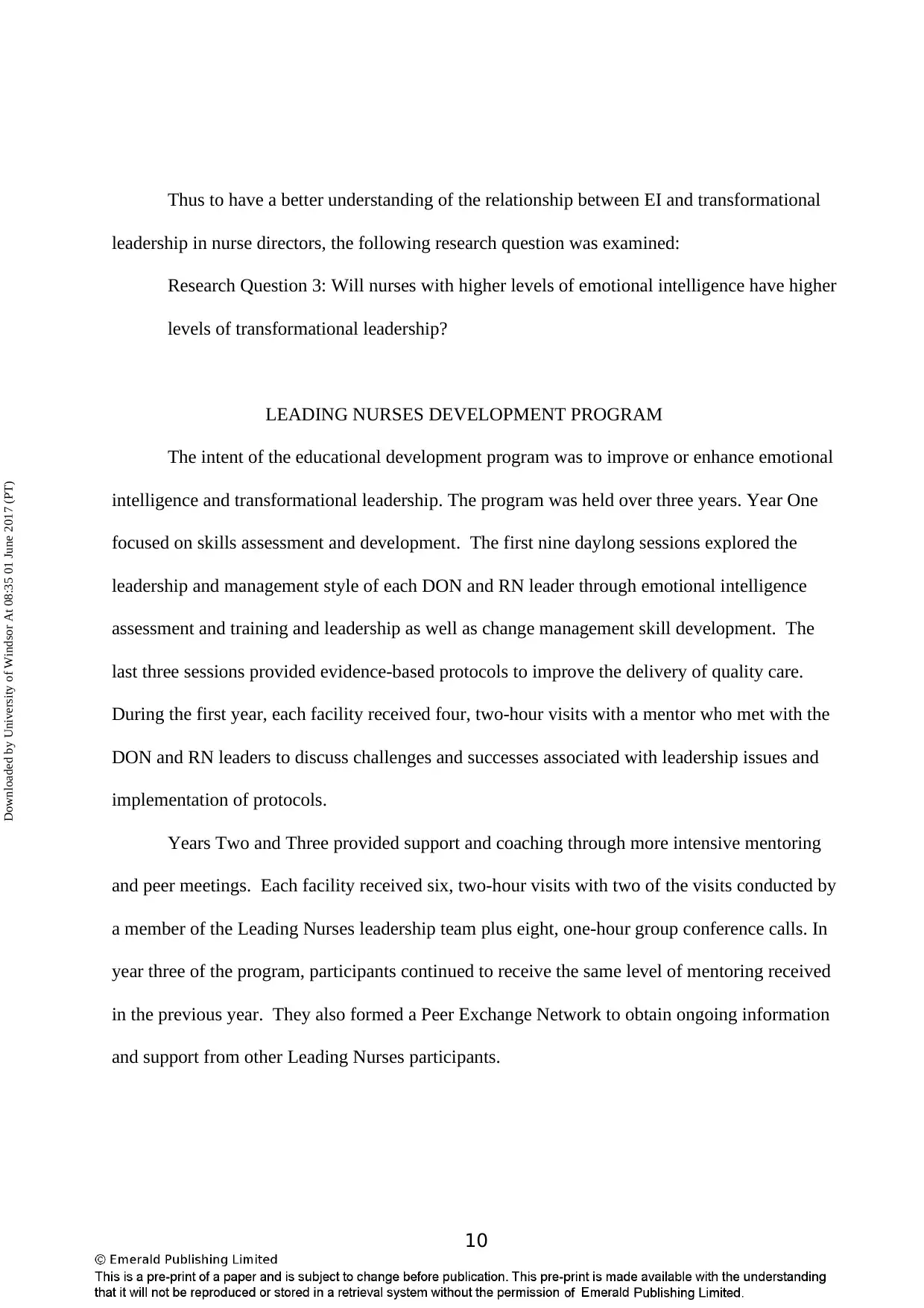
10
Thus to have a better understanding of the relationship between EI and transformational
leadership in nurse directors, the following research question was examined:
Research Question 3: Will nurses with higher levels of emotional intelligence have higher
levels of transformational leadership?
LEADING NURSES DEVELOPMENT PROGRAM
The intent of the educational development program was to improve or enhance emotional
intelligence and transformational leadership. The program was held over three years. Year One
focused on skills assessment and development. The first nine daylong sessions explored the
leadership and management style of each DON and RN leader through emotional intelligence
assessment and training and leadership as well as change management skill development. The
last three sessions provided evidence-based protocols to improve the delivery of quality care.
During the first year, each facility received four, two-hour visits with a mentor who met with the
DON and RN leaders to discuss challenges and successes associated with leadership issues and
implementation of protocols.
Years Two and Three provided support and coaching through more intensive mentoring
and peer meetings. Each facility received six, two-hour visits with two of the visits conducted by
a member of the Leading Nurses leadership team plus eight, one-hour group conference calls. In
year three of the program, participants continued to receive the same level of mentoring received
in the previous year. They also formed a Peer Exchange Network to obtain ongoing information
and support from other Leading Nurses participants.
Downloaded by University of Windsor At 08:35 01 June 2017 (PT)
Thus to have a better understanding of the relationship between EI and transformational
leadership in nurse directors, the following research question was examined:
Research Question 3: Will nurses with higher levels of emotional intelligence have higher
levels of transformational leadership?
LEADING NURSES DEVELOPMENT PROGRAM
The intent of the educational development program was to improve or enhance emotional
intelligence and transformational leadership. The program was held over three years. Year One
focused on skills assessment and development. The first nine daylong sessions explored the
leadership and management style of each DON and RN leader through emotional intelligence
assessment and training and leadership as well as change management skill development. The
last three sessions provided evidence-based protocols to improve the delivery of quality care.
During the first year, each facility received four, two-hour visits with a mentor who met with the
DON and RN leaders to discuss challenges and successes associated with leadership issues and
implementation of protocols.
Years Two and Three provided support and coaching through more intensive mentoring
and peer meetings. Each facility received six, two-hour visits with two of the visits conducted by
a member of the Leading Nurses leadership team plus eight, one-hour group conference calls. In
year three of the program, participants continued to receive the same level of mentoring received
in the previous year. They also formed a Peer Exchange Network to obtain ongoing information
and support from other Leading Nurses participants.
Downloaded by University of Windsor At 08:35 01 June 2017 (PT)
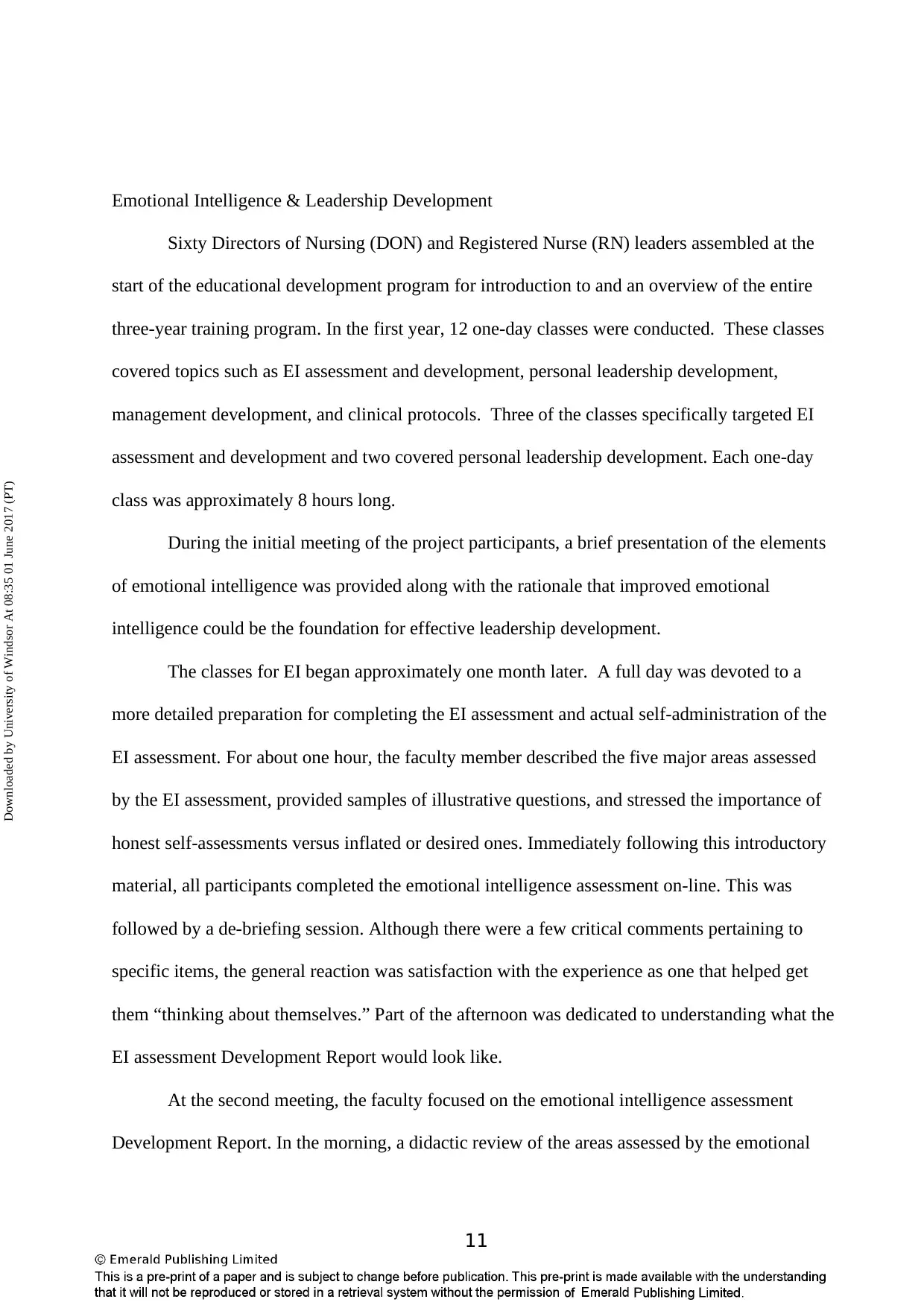
11
Emotional Intelligence & Leadership Development
Sixty Directors of Nursing (DON) and Registered Nurse (RN) leaders assembled at the
start of the educational development program for introduction to and an overview of the entire
three-year training program. In the first year, 12 one-day classes were conducted. These classes
covered topics such as EI assessment and development, personal leadership development,
management development, and clinical protocols. Three of the classes specifically targeted EI
assessment and development and two covered personal leadership development. Each one-day
class was approximately 8 hours long.
During the initial meeting of the project participants, a brief presentation of the elements
of emotional intelligence was provided along with the rationale that improved emotional
intelligence could be the foundation for effective leadership development.
The classes for EI began approximately one month later. A full day was devoted to a
more detailed preparation for completing the EI assessment and actual self-administration of the
EI assessment. For about one hour, the faculty member described the five major areas assessed
by the EI assessment, provided samples of illustrative questions, and stressed the importance of
honest self-assessments versus inflated or desired ones. Immediately following this introductory
material, all participants completed the emotional intelligence assessment on-line. This was
followed by a de-briefing session. Although there were a few critical comments pertaining to
specific items, the general reaction was satisfaction with the experience as one that helped get
them “thinking about themselves.” Part of the afternoon was dedicated to understanding what the
EI assessment Development Report would look like.
At the second meeting, the faculty focused on the emotional intelligence assessment
Development Report. In the morning, a didactic review of the areas assessed by the emotional
Downloaded by University of Windsor At 08:35 01 June 2017 (PT)
Emotional Intelligence & Leadership Development
Sixty Directors of Nursing (DON) and Registered Nurse (RN) leaders assembled at the
start of the educational development program for introduction to and an overview of the entire
three-year training program. In the first year, 12 one-day classes were conducted. These classes
covered topics such as EI assessment and development, personal leadership development,
management development, and clinical protocols. Three of the classes specifically targeted EI
assessment and development and two covered personal leadership development. Each one-day
class was approximately 8 hours long.
During the initial meeting of the project participants, a brief presentation of the elements
of emotional intelligence was provided along with the rationale that improved emotional
intelligence could be the foundation for effective leadership development.
The classes for EI began approximately one month later. A full day was devoted to a
more detailed preparation for completing the EI assessment and actual self-administration of the
EI assessment. For about one hour, the faculty member described the five major areas assessed
by the EI assessment, provided samples of illustrative questions, and stressed the importance of
honest self-assessments versus inflated or desired ones. Immediately following this introductory
material, all participants completed the emotional intelligence assessment on-line. This was
followed by a de-briefing session. Although there were a few critical comments pertaining to
specific items, the general reaction was satisfaction with the experience as one that helped get
them “thinking about themselves.” Part of the afternoon was dedicated to understanding what the
EI assessment Development Report would look like.
At the second meeting, the faculty focused on the emotional intelligence assessment
Development Report. In the morning, a didactic review of the areas assessed by the emotional
Downloaded by University of Windsor At 08:35 01 June 2017 (PT)
⊘ This is a preview!⊘
Do you want full access?
Subscribe today to unlock all pages.

Trusted by 1+ million students worldwide
1 out of 29
Your All-in-One AI-Powered Toolkit for Academic Success.
+13062052269
info@desklib.com
Available 24*7 on WhatsApp / Email
![[object Object]](/_next/static/media/star-bottom.7253800d.svg)
Unlock your academic potential
Copyright © 2020–2025 A2Z Services. All Rights Reserved. Developed and managed by ZUCOL.